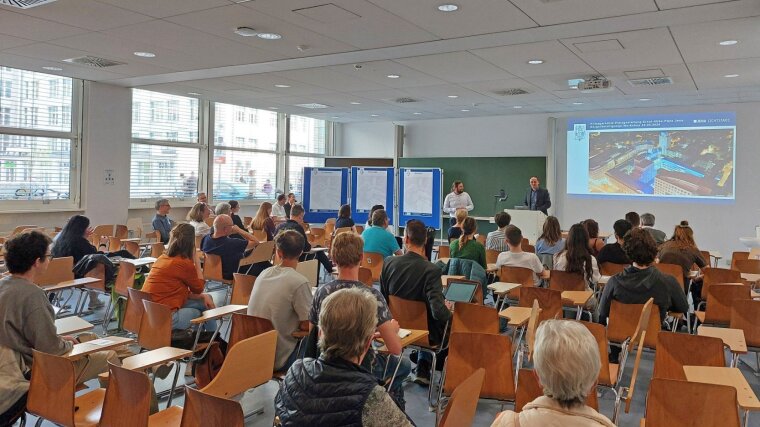
Published:
Public participation started with a workshop
The public participation process for the redesign of Ernst-Abbe-Platz got off to a successful start last Friday with a workshop. Around 50 participants, including students, employees of the university, employees of Studierendenwerk Thüringen and the city administration as well as younger and older citizens, came to discuss and work out what requirements there are for the area. The Green Office and the university's climate protection management also took part in the workshop and contributed new ideas.
As one of the central squares in Jena's city center, Ernst-Abbe-Platz combines a variety of functions: It is a connection point for public transportation, serves as an event location and as an outdoor area for the university. The requirements that need to be taken into account during the redesign are correspondingly diverse. The completely sealed square is one of the hottest places in the city and at the same time an area with high usage, emphasized mayor and department head Christian Gerlitz in his introduction.
Problems, requirements and potential
In small groups, the participants discussed the problems and potential of Ernst-Abbe-Platz and collected ideas for its redesign.
Image: Stadt JenaFollowing the introductory presentation, the participants discussed the problems and potential of the square in three groups and formulated needs and requirements for the redesign. Innovative greening, the active use of rainwater, water features, light art, relocation of the parking garage entrances, mobile seating, clear pathways, vertical design and, above all, "more green" - the numerous constructive suggestions clearly showed how different the use and therefore the requirements of the square are.
Online participation starts
The results of the workshop will be published on the city's participation platformExternal link. From 23.04.2024, 14:00, to 12.05.2024, 24:00, they can be evaluated and commented on here. Further up-to-date information on the project will also be added to the platform in future. The results of the public participation will be incorporated into the planning together with the requirements of the funding body. An important aspect of the redesign is climate-adapted design. Therefor, the federal government is supporting the conversion with funds of around 6.3 million euros as part of the "Adapting urban spaces to climate change" funding program. This funding of 85 percent of the conversion costs is intended to turn the current heat hotspot into a climate oasis in Jena's urban space.
Background information
The approximately 10,000 square meter Ernst-Abbe-Platz functions as the campus of the Friedrich Schiller University and is therefore a central communication space for students. At the same time, the inner-city square combines a wide variety of uses, such as science, education, health, shopping, administration and gastronomy. The pedestrian frequency is further increased by the terminus of a streetcar line and the exits of the underground parking garages beneath the square. Due to the aging design of the square, the constantly increasing pressure of use and the increasing heat load in the inner city area, the area no longer meets the requirements of modern, inner-city squares. Accordingly, a fundamental redesign is going to take place. The underground car parks directly beneath the square, which only have a limited load-bearing capacity, pose a particular challenge. As a result, the backfilling of soil on a larger scale or the planting of trees is only possible to a very limited extent.
